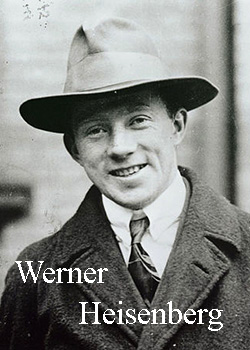Indeterminacy
Today, we look for reality. The University of Houston presents this series about the machines that make our civilization run and the people whose ingenuity created them.
 Early in the play Copenhagen, physicist Werner Heisenberg complains, "Everyone understands uncertainty, or thinks he does." And who indeed has not heard of his Uncertainty Principle. But do we really get it? Most of us understand that our measurements will always have some inaccuracy. But that's far from the whole story. Let's think a bit about measurement.
Early in the play Copenhagen, physicist Werner Heisenberg complains, "Everyone understands uncertainty, or thinks he does." And who indeed has not heard of his Uncertainty Principle. But do we really get it? Most of us understand that our measurements will always have some inaccuracy. But that's far from the whole story. Let's think a bit about measurement.
First, there's the Observer Effect. It says that any observation affects the thing it's observing. A thermometer absorbs a teeny bit of heat to expand its mercury, and that cools the air it's measuring. Or we let a little bit of air into our tire pressure gauge, which lowers the pressure we're trying to measure. And so on. Those effects are usually small; but they're always there.
But the observer effect says nothing about the limits of accuracy. So let's meet American physicist, Earle Kennard. He spent a sabbatical with Heisenberg at G�ttingen University. There, Kennard asked, "What's the most delicate measurement imaginable?"
That'd be bouncing a single photon of light off an electron to find the electron's position and momentum. Kennard found the error in momentum times the error in position would always be larger than about a 13th of Planck's constant. That's unimaginably small, but it's not zero. It means: the more exactly we want to know the electron's position, the more error we'll get in its momentum.
So Heisenberg pointed out that we have no reason to expect to find any determinate reality when things get small enough. After all, solid reality is just an idea we cook up to match our perceptions - like a flat earth or an earth-centered universe.
He used the word indeterminacy, not uncertainty. It isn't just a matter of our being uncertain of exact values. We really have no reason to believe that exact values really exist. We need to admit that reality itself is indeterminate. The very foundations of the hard earth we walk upon are fuzzy and blurred.
Quantum mechanics had, by then, shown that energy is not infinitely divisible. It's not like our notions of time or distance. Energy can assume either of two values, very close to each other, but nothing in between. Heisenberg saw that didn't just mean gaps on our knowledge of reality - but gaps in reality itself.
From that moment onward, we lived in a new kind of universe, just as we had after Copernicus and Galileo made it clear that Earth was not at the center of all things. After Heisenberg, the seeming unrealities grew greater every year. Einstein's relativity had been bad enough. Now this! The great Cal Tech physicist, Richard Feynman, finally cried, "If you think you understand quantum mechanics, you don't understand quantum mechanics"
I know - it's disturbing that, after Heisenberg, we cannot escape the fact that solid reality is only a large-scale illusion. At the same time, that means the real world is a more deliciously puzzling place than any of us first dreamt it to be.
I'm John Lienhard at the University of Houston, where we're interested in the way inventive minds work.
See the Wikipedia articles on The Uncertainty Principle, The Observer Effect, Werner Heisenberg, and Earle Hesse Kennard.
I wrote this episode after having been involved with Houston's Main Street Theater production of Michael Frayn's play Copenhagen, which brilliantly illuminates the idea of uncertainty. The play, directed by Guy Roberts, ran Feb. 11 through March 12, 2017.

Scene from the Main Street Theater production of Copenhagen: Niels Bohr (Joel Sandel), Margrethe Bohr (Celeste Roberts), and Werner Heisenberg (Philip Hayes) wrestle with the uncertainty of what really happened when they met in Copenhagen in 1941. Click here for a slide show of images from the play.
For more on Heisenberg, uncertainty, and quantum mechanics; see: C. L. Tien & J. H. Lienhard, Statistical Thermodynamics. (NY: Hemisphere Pub. Corp.) 1979. Ch. 4
Among the books from which I first learned of these matters was E. H. Kennard's, Kinetic Theory of Gases. With an Introduction to Statistical Mechanics. (NY: McGraw-Hill Book Co. Inc.) 1938. Kennard's calculation gave Δx • Δp ≥ h/4π, where Δx and Δp are incremental errors in position and momentum respectively and h is Planck's constant, h = 6.62607004 x 10-34 m2kg/s - a seriously small number.
I've dodged a huge important issue here: It is that particles have wavelike properties. The photon and electron that Kennard thought about are actually spread out in space. That's a complex matter for another day. But, if you're interested, I recommend this excellent TED talk, which treats Heisenberg's Uncertainty in those terms: https://www.youtube.com/watch?v=TQKELOE9eY4.
The Heisenberg photo is courtesy of Wikimedia Commons. Photo of the play by John H. Lienhard.
This episode was first aired on February 6, 2017